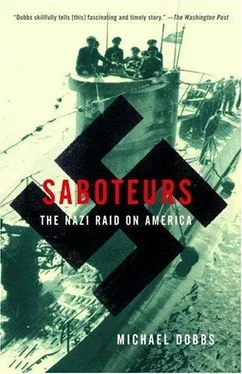More troubling still, Hitler now faced a powerful new adversary following the Japanese attack on Pearl Harbor the previous December. America’s entry into the war posed few immediate dangers to Germany: despite rapid mobilization, the U.S. Army was in no condition to fight a much more seasoned German army, even supposing it could somehow gain a foothold on the European continent. Over the long term, however, American involvement was likely to shift the balance of industrial, and therefore military, power in favor of the anti-Nazi coalition. It promised to provide Britain and Russia with an almost inexhaustible supply of war matériel and manpower that Germany was unable to match, even with the help of its allies, Japan and Italy.
In the end, victory was likely to go to the side that produced the largest number of airplanes, tanks, and ships. And here Germany was at a huge disadvantage. By December 1941, the third winter of the war, Hitler’s armies were in the throes of a logistical crisis. Thousands of tanks and airplanes had been lost on the Russian front. Equipment that performed well in Belgium or France seized up on the frozen Russian steppes; the mighty Wehrmacht was reduced to using horses to drag its guns toward Moscow. It was not just tanks and guns that were in short supply. German soldiers fighting in Russia lacked coats, gloves, and boots, and were even showing signs of malnourishment. Their commanders made frantic appeals to civilians back home for warm clothing. In January 1942, Hitler reversed earlier statements about Germany’s invincible industrial might and gave his fellow countrymen an inkling of the gravity of the situation:
The people at home know what it means to lie in snow and ice at a temperature of 35, 38, 40, and 42 degrees below zero, in order to defend Germany. And, because they know it, they are anxious to do whatever they can. It is my duty to issue the summons: Germans at home! Work, produce arms, produce munitions. More arms, and more munitions! By doing so, you will save the life of many a comrade at the front. Produce, and work at our means of transportation, so that everything will get to the front. 3
In the meantime, on the other side of the Atlantic, America was dramatically increasing the production of iron, aluminum, and steel, the first step to churning out the tanks, airplanes, and submarines needed to win the war. At the end of 1940, President Franklin D. Roosevelt had held out a vision of America as “the great arsenal of democracy,” using its “industrial genius” to “produce more ships, more guns, more planes, more of everything.” 4By 1942, the United States was well on the way to fulfilling Roosevelt’s goal, producing 60,000 planes, 45,000 tanks, 20,000 antiaircraft guns, and six million tons of shipping in a single year. If these trends continued, Germany would be overwhelmed by the sheer weight of America’s industrial power.
Having served in the trenches in World War I, Hitler was unimpressed by the fighting qualities of Americans, whom he regarded as hopelessly pampered and effete. “I’ll never believe that an American soldier can fight like a hero,” he told his associates one evening soon after America’s entry into the war, as they sat around the dinner table at the Wolf’s Lair. 5American ideas of democracy and free-market capitalism filled Hitler with “hatred and repugnance.” He thought of America as a “decayed country” with no future. “Everything about the behavior of American society reveals that it’s half Judaised, half negrified. How can one expect a state like that to hold together—a country where everything is built on the dollar?” 6He was even more scathing about the leadership abilities of the American ruling class, particularly Roosevelt, “a tortuous, pettifogging Jew” with a “sick brain.” 7
For all his contempt for America and Americans, Hitler had enormous respect for American industry. He admired the auto manufacturer Henry Ford, and not just because of their shared anti-Semitism. Germany had a lot to learn from the techniques of mass production pioneered by Ford, he told his subordinates. “The great success of the Americans consists essentially in the fact that they produce quantitatively as much as we do with two-thirds less labor… In America, everything is machine-made, so they can employ the most utter cretins in their factories. Their workers have no need of specialized training, and are therefore interchangeable.” 8And if America could produce cars in such vast numbers, at much less cost than Germany, what was there to prevent it from achieving a similar feat with tanks?
If Germany was to win the war, it would have to find a way of counteracting America’s industrial power. This was not just Hitler’s opinion. It was also the view of his most trusted aides, including Hermann Göring, the head of the Luftwaffe, and Heinrich Himmler, head of the Gestapo and the S.S., the shock troops of the Nazi regime. 9
For months, both men had complained about the Abwehr’s failure to establish reliable agents in the United States. Göring, in particular, was constantly warning Hitler about the threat posed by American industry. Something had to be done to sabotage the U.S. war machine.
In a series of meetings with Canaris, before and after Pearl Harbor, Hitler demanded action. 10The Abwehr chief was skeptical of the value of sabotage operations in the United States, not for deep-seated moral qualms, but because he feared they would be counterproductive. The history of German sabotage attempts against America in World War I—such as blowing up the Black Tom ammunition depot in New York Harbor— suggested that any short-term gains were likely to be outweighed by propaganda losses and heightened anti-German sentiment. Even successful sabotage operations, Canaris felt, were unlikely to have a decisive impact on the outcome of the war.
As long as the United States remained an ostensibly neutral country, the German foreign ministry under Joachim von Ribbentrop was also opposed to acts of sabotage on American soil. Ribbentrop hoped that skillful diplomacy would keep America out of the war, but this was hardly possible if Americans found out that the Abwehr was trying to destroy American factories. Canaris was able to cite Ribbentrop’s objections to sabotage as an excuse for doing nothing. 11He told Hitler that the foreign ministry had categorically forbidden the Abwehr to build an intelligence network in the United States that could be used for sabotage operations.
The diplomatic arguments against sabotage disappeared as a result of the U.S. entry into the war. After Pearl Harbor, Hitler stepped up his demands for large-scale action against the American aircraft industry to prevent the Luftwaffe from losing control of the skies. Canaris understood that he could not procrastinate indefinitely without risking his own position. The British and American press were already talking about the Abwehr chief as a possible leader of a homegrown German opposition to Hitler. In conversations with Nazi officials, Canaris laughed off these reports as wishful thinking by the enemy and an attempt to sow high-level dissension in Berlin. All the same, he felt a need to demonstrate his loyalty to the Führer.
In the meantime, Nazi officials had produced their own scheme for infiltrating agents into the United States. The plan was the brainchild of Walter Kappe, the former propaganda chief of the German-American Bund, an American offshoot of the German Nazi Party. Kappe had lived in America for twelve years but returned to Germany in 1937 after losing a power struggle with other American Nazis. He had joined the Abwehr at the beginning of the war, with the rank of lieutenant. His real influence, however, derived from the gold button he wore in his lapel, signifying that he was one of the Nazi Party’s first hundred thousand members, a Hitler loyalist dating back to the early twenties, when it was far from obvious that the Nazis would come to power.
Читать дальше












